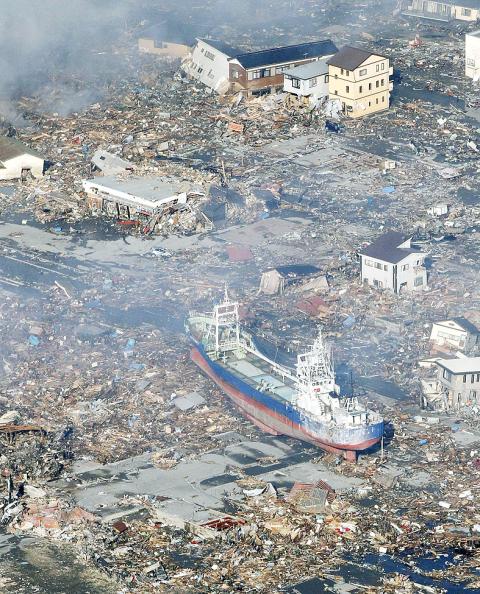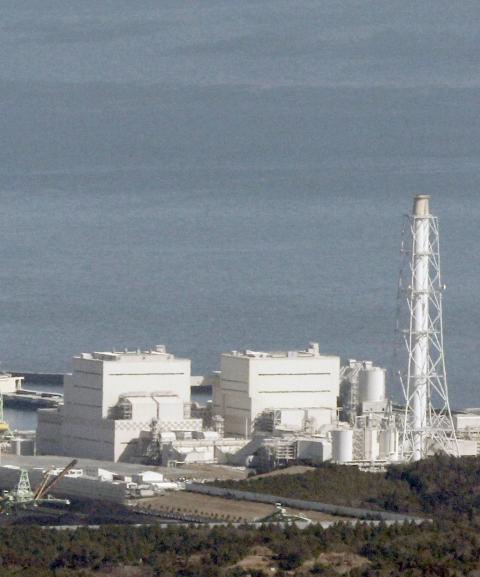An explosion and feared meltdown at a Japanese nuclear plant yesterday exposed the scale of the disaster facing the country after a massive quake and tsunami left more than 1,000 dead.
Japanese Prime Minister Naoto Kan said the magnitude 8.9 quake and the terrifying tsunami that followed were an “unprecedented national disaster” and vowed to protect those living near the stricken plant.
Reactor cooling systems failed at two nuclear facilities after Friday’s record earthquake, which unleashed a terrifying 10m tsunami that tore through coastal towns and cities, destroying everything in its path.

Photo: Reuters
Smoke was seen billowing from the Fukushima No. 1 atomic plant about 250km northeast of Tokyo after an explosion at the site.
Kyodo News agency said radioactive caesium had been detected near the aging facility, citing the nuclear safety agency.
However, Kan’s top spokesman, Yukio Edano, said that the Fukushima plant’s operator had reported the reactor container was not damaged and that radiation levels near it had fallen after the blast.

Photo: Reuters
Kyodo and Jiji reported before the explosion that the plant “may be experiencing nuclear meltdown,” while public broadcaster NHK quoted the safety agency as saying metal tubes that contain uranium fuel may have melted.
The cooling system of the plant was damaged in the massive earthquake that struck the region 24 hours earlier, leaving authorities scrambling to fix the problem and evacuate tens of thousands of people within a 20km radius.
Thousands were evacuated near another damaged plant, Fukushima No. 2.
The atomic emergency came as the country struggled to assess the full extent of the devastation wreaked by the massive tsunami, which was unleashed by the strongest quake ever recorded in Japan.
The wall of water pulverized towns and cities along the northeastern coast. Police reportedly said 200 to 300 bodies had been found in the city of Sendai.
About 300 to 400 bodies were recovered in Rikuzentakata, a coastal town of about 23,000 people, NHK quoted the military as saying.
The Fire and Disaster Management Agency said the tsunami had obliterated the town.
It was not immediately clear whether any of the bodies found by the military were included in police tolls showing at least 700 people dead. The government spokesman said at least 1,000 people were believed to have lost their lives.
More than 215,000 people were huddled in emergency shelters, police said.
The full scale of those left homeless was believed to be much higher, with police saying they had not received a tally from Miyagi Prefecture, the hard-hit region that is home to Sendai.
NHK reported that about 10,000 people are unaccounted for in the Japanese port town of Minamisanriku in Miyagi. The figure is more than half of the town’s population of about 17,000, it said.
Local authorities are trying to find their whereabouts with the help of Japan’s Self-Defense Forces, NHK said.
The raging tsunami picked up shipping containers, cars and the debris of shattered homes. It crashed through the streets of Sendai and across open fields, forming a mud slick that covered vast tracts of land.
“There are so many people who lost their lives,” an elderly man told TV reporters before breaking down in tears. “I have no words to say.”
Authorities said more than 3,000 homes were destroyed or swept away.
About 50,000 military and other rescue personnel were spearheading a Herculean rescue and recovery effort with hundreds of ships, aircraft and vehicles headed to the Pacific coast area.
Army helicopters airlifted people off the roof of an elementary school in Watari, Miyagi Prefecture.
In quake-hit areas, 5.6 million households had no power yesterday and more than 1 million households were without water. Telecommunications networks were also hit.
The quake, which hit at 2:46pm and lasted about two minutes, rattled buildings in greater Tokyo, the world’s largest urban area and home to about 30 million people.
More than 24 hours after the first, massive quake struck about 400km northeast of Tokyo, aftershocks were still rattling the region, including a strong magnitude 6.8 tremor yesterday.
The US Geological Survey said more than 100 aftershocks had hit the area.

ACTION PLAN: Taiwan would expand procurement from the US and encourage more companies to invest in the US to deepen bilateral cooperation, Lai said The government would not impose reciprocal tariffs in retaliation against US levies, President William Lai (賴清德) said yesterday, as he announced five strategies to address the issue, including pledging to increase Taiwanese companies’ investments in the US. Lai has in the past few days met with administrative and national security officials, as well as representatives from various industries, to explore countermeasures after US President Donald Trump on Wednesday last week announced a 32 percent duty on Taiwanese imports. In a video released yesterday evening, Lai said that Taiwan would not retaliate against the US with higher tariffs and Taiwanese companies’ commitments to

Intelligence agents have recorded 510,000 instances of “controversial information” being spread online by the Chinese Communist Party (CCP) so far this year, the National Security Bureau (NSB) said in a report yesterday, as it warned of artificial intelligence (AI) being employed to generate destabilizing misinformation. The bureau submitted a written report to the Legislative Yuan in preparation for National Security Bureau Director-General Tsai Ming-yen’s (蔡明彥) appearance before the Foreign Affairs and National Defense Committee today. The CCP has been using cognitive warfare to divide Taiwanese society by commenting on controversial issues such as Taiwan Semiconductor Manufacturing Co’s (TSMC, 台積電) investments in the

HELPING HAND: The steering committee of the National Stabilization Fund is expected to hold a meeting to discuss how and when to utilize the fund to help buffer the sell-off The TAIEX plunged 2,065.87 points, or 9.7 percent, to close at 19,232.35 yesterday, the highest single-day percentage loss on record, as investors braced for US President Donald Trump’s tariffs after an extended holiday weekend. Amid the pessimistic atmosphere, 945 listed companies led by large-cap stocks — including Taiwan Semiconductor Manufacturing Co (TSMC, 台積電), Hon Hai Precision Industry Co (鴻海精密) and Largan Precision Co (大立光) — fell by the daily maximum of 10 percent at the close, Taiwan Stock Exchange data showed. The number of listed companies ending limit-down set a new record, the exchange said. The TAIEX plunged by daily maxiumu in just

‘COMPREHENSIVE PLAN’: Lin Chia-lung said that the government was ready to talk about a variety of issues, including investment in and purchases from the US The National Stabilization Fund (NSF) yesterday announced that it would step in to staunch stock market losses for the ninth time in the nation’s history. An NSF board meeting, originally scheduled for Monday next week, was moved to yesterday after stocks plummeted in the wake of US President Donald Trump’s announcement of 32 percent tariffs on Taiwan on Wednesday last week. Board members voted to support the stock market with the NT$500 billion (US$15.15 billion) fund, with injections of funds to begin as soon as today. The NSF in 2000 injected NT$120 billion to stabilize stocks, the most ever. The lowest amount it